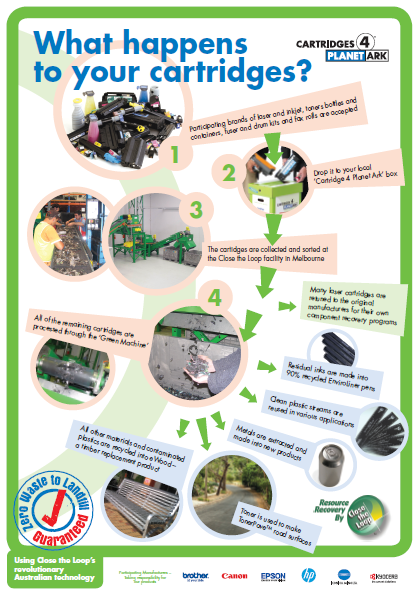Epson has been a member of the C4PA program since its inception in April 2003 and 12 years on now recycle approximately 23,000 cartridges per month through C4PA.
“We’d like to congratulate Epson on this fantastic achievement,” said Ryan Collins, Recycling Programs Manager at Planet Ark. “Their commitment to product stewardship helps provide consumers a free and easy way to recycle their cartridges and keeps the materials in use rather than in landfill.”
At the end of the recycling process, the used ink cartridges are transformed into an array of products including plastic rulers, pens (even the ink in the pen is from the old cartridges), park benches and E-Wood.

Collection boxes for the 'Cartridges 4 Planet Ark' program can be found in Officeworks and JB Hi-Fi stores and participating Australia Post, Harvey Norman, Dick Smith, The Good Guys and Office National outlets as well as workplace collections.
|
|
‘Cartridges 4 Planet Ark’ Program
‘Cartridges 4 Planet Ark' is an innovative recycling program that provides Australians with a free, easy and environmentally-accredited way to recycle their used printer cartridges. As cartridges comprise a complex mix of plastics, metal, inks and toners, they represent a significant investment in resources. When they are disposed of into landfill, these resources are lost. That is why Planet Ark joined with Close the Loop and the participating manufacturers to set up the innovative 'Cartridges 4 Planet Ark' program. This program collects and returns cartridges for remanufacturing and recycling - therefore keeping them out of landfill. C4PA’s Melbourne-based recycling partner, Close the Loop, is independently audited on an annual basis for its zero waste to landfill guarantee. (Excerpt of the Cartridges 4 Planet Ark website, 2015).
Epson Environmental Vision 2050
Epson is working to preserve the natural environment by providing products that tread lightly on the Earth. To achieve this, Epson has set four key conditions in order to work towards achieving "Environmental Vision 2050":
1. Reduction of CO2 emissions by 90% across the entire product life cycle.
2. Inclusion of all products in the resource reuse and recycling loop.
3. Reduction of direct CO2 emissions by 90%, and elimination of global warming gas emissions other than CO2.
4. Restoration and preservation of biodiversity as a member of the ecosystem, together with local communities.














































